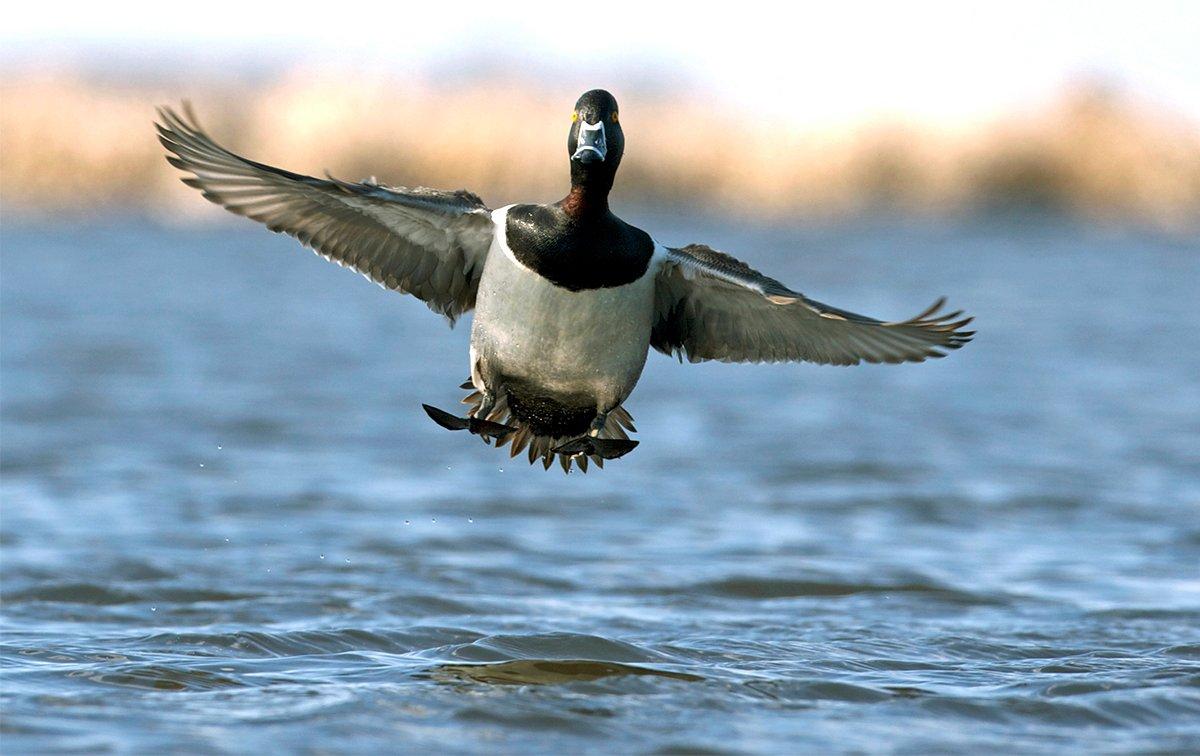Effort Tracks Birds From Wintering Grounds to Breeding Areas
New research spearheaded by Delta Waterfowl could shed light on the movements, nesting behavior and wintering-ground requirements of ring-necked ducks, an increasingly popular and important species.
The study is exciting for several reasons — mainly because ringnecks have been studied far less than any of the most harvested duck species. Further, ringnecks are expanding in numbers and range, so the study marks one of the first times researchers can study a duck on the upswing. In addition, this is the first time researchers have implanted radio transmitters in ringnecks to study their movements. Banding data for the species is lacking, so biologists know relatively little about the birds' migration routes or breeding destinations.
We want to learn as much as we can about them, said Joel Brice, vice president of waterfowl and hunter recruitment programs for Delta Waterfowl. A lot of it is life history information — what do they do, what makes them tick. Also, there may be things we learn about habitat use on the wintering grounds, and there may be some management implications there.
The project, conducted cooperatively by Delta and the University of Georgia, is tracking ringnecks from their Georgia wintering grounds to their vast breeding area in the northern United States and Canada. Beginning in November 2017, researchers implanted transmitters in 14 ringneck hens. Nine are still transmitting.
Honestly, the question originated from a Southern hunter's perspective of, 'Where are my ringnecks coming from?' Brice said. It's a bird that, despite being so abundant and frequent in the harvest, there's just not a lot of information about them, and that's the exciting part.
As of June 15, Brice said, tracking data indicated that eight of the nine the ringneck hens have settled into small home ranges at breeding grounds in British Columbia, Saskatchewan, Manitoba and Ontario. The other hen is in northern Manitoba but has not settled into one area, so she's considered an outlier hen and likely won't nest this year.
Transmitter signals during the birds' flight north revealed interesting migratory behavior.
In one of our YouTube videos with (Delta's Dr. Frank Rohwer and graduate student Tori Mezebish), you're basically actually able to see how the snow line affects … migration patterns and how quickly they make it up North to the breeding grounds. You could actually follow their movement with the snow lines.
Two ducks began moving from breeding grounds in late February and stopped in Alabama and Kentucky. By late march, most of the hens had left Georgia, but late snowstorms pushed the snow line south. One hen might have overshot her first jump — to northern Lake Michigan — and then backtracked south. In late April, all hens had started migrating, but more late-season snowstorms held the ducks in the United States, at or just south of the snow line. By April 29, warm weather freed much of the country from snow, and the ringnecks migrated farther into Minnesota, North Dakota and Ontario. By May 7, the snow line pushed far north into Canada, and several hens migrated to Saskatchewan and Ontario.
Brice said the study might also reveal important information about how ringnecks use wintering grounds. Researchers implanted the ducks with transmitters in November, but the birds didn't start migrating until months later, so observers monitored the birds for several weeks at their winter habitat.
Where do they go, and what do they eat? Brice asked. A lot of Southern duck management is for dabblers, and I think it's largely assumed that's what everybody does. So what are ringnecks doing on the wintering grounds? Honestly, that probably has the greatest management significance or potential.
The study will continue through 2018-'19, Brice said. The current transmitters will run out of power by August. Researchers plan to fit up to 40 ringnecks with transmitters late this fall at wintering grounds in Georgia and South Carolina, and that portion of the study might also include some drakes. After those transmitters cease working in Summer 2019, researchers can analyze the data and look for conclusions.
And that information, Brice said, could prove vitally important in the future, as ringnecks already rank in the top 10 for annual nationwide harvest, including third in the Atlantic Flyway.
We kind of suspect this bird will continue to increase, he said. They're probably going to make up more the bag in the future.
And thanks to Delta Waterfowl and the University of Georgia, ringneck hunters will soon know a lot more about the birds they pursue.
Click here for more Realtree waterfowl hunting content. And check us out on Facebook.







